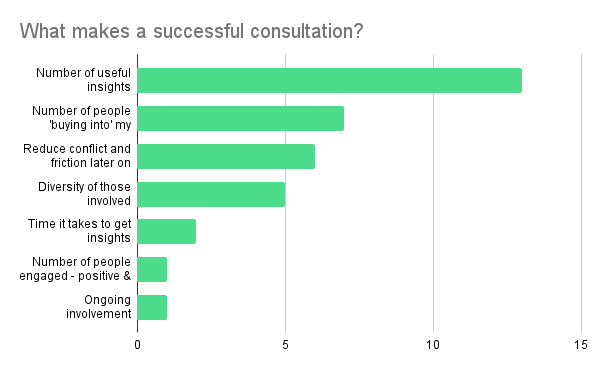Consultation and engagement with residents are vital to making planning and construction projects more responsive to local needs and concerns. Ideally, every planner would engage with residents affected by plans at the earliest opportunity possible. In reality, planners can be hesitant. They might feel anxious about opening a project up to the public as any changes to plans are constrained by the business case and design direction.
At PlaceChangers, we often ask what makes a consultation successful. We recognise that the answer differs between project owners. This article reflects on our experience and a user poll we have been running on attitudes towards consultation success.
What people in the industry see as a successful planning consultation
We recently ran a short survey with town planners who undertake public consultations to understand what a successful consultation process looked like for them. While not statistically significant, it reflects attitudes and trends.
Here are the results from our poll:

Number of useful insights
The most critical outcome for respondents was their ability to generate valuable insights. This was mentioned by 61% of respondents and outstripped all other responses.
Number of people ‘buying into’ my project
Closely related to this response option, 33% of respondents also thought a successful consultation would help them get people ‘buy into’ the proposed project.
Reduce friction and conflict later on
This was followed by 29% of people saying the consultation is successful if it reduces any potential friction later in the project, mainly when the planning application is submitted. This response reflects the hope that community engagement will ensure residents have a level of support for the project and more readily enable councillors and officers to approve projects when the planning application is submitted.
Diversity of those involved
Respondents also thought that it was important who got involved. Diversity was important for 24% of respondents, often described as a ‘balanced’ response. Ideally, the consultation would reflect the socio-demographic makeup of the area. Still, for project owners, this ‘diversity’ often means more reflection of the ‘for’ and ‘against’ factions or the key stakeholders in the project.
The time it takes to get insights
Surprisingly, respondents were okay with how long it took to gather insights from public planning consultations. 10% of respondents mentioned this as a key success factor.
Other factors
Other factors came through as well, such as the level of ongoing engagement, which is essential in larger multi-year projects or where multiple consultation stages are aligned to the design's evolution. On most smaller projects, continued involvement with residents needs to be more appreciated. 61% of respondents were from firms with 50 or fewer staff, which may mean that smaller projects were over-represented in this poll.
Quality over quantity counts in a successful planning consultation
Overall, the message from respondents appears to be focused on the value of insight and productive dialogue: Regarding successful planning engagement and consultations, the rule of thumb is ‘quality over quantity’.
When measuring success, several different metrics can be used to assess what a successful consultation looks like. Especially digital platforms that support planning consultations, such as PlaceChangers, provide a raft of optimisations to ensure that the dialogue in a consultation is productive.
Make it easy to get involved
To get quality, consultations do require a degree of quantity. And it is helpful to understand what kind of response levels a project will likely get. Here response rates are a crucial factor.
In a typical planning consultation (event) it was often difficult to gauge response rates, as it was unclear who viewed or received consultation invitations. With online tools, such as PlaceChangers planning consultation tool, it is increasingly possible to understand these aspects in much greater detail.
- Reach: This is how far our invites to consultations travelled regarding the number of people we reached.
- The number of visitors: The number of people who come past our consultation as window shoppers.
- Responses: The number of people who then responded to our consultation.
According to a 2018 review note by Islington Council, a typical response rate in planning consultations is about 9% to 12%. This is based on a SurveyMonkey survey advertised to local households by post.
Making consultation discussions meaningful
The other core part of a results-driven consultation that’s of most significant interest to most respondents is the quality of the response. Quality, like beauty, is often in the eye of the beholder. A couple of considerations for this discussion are:
- Engaging at the earliest point possible would have the greatest possible result, as the project design can be changed more easily. However, early engagement is rarely done, a topic for a different blog.
- The other apparent gap is between what planners and the public care about.
In the UK, planners have the term ‘material concern’, which refers to any issues that make a difference to the design. There’s often an association with various surveys and studies on the site, and the business case/feasibility (‘what the client wants’) plays into this, too.
On the other hand, community respondents rarely have a view on what is a material concern. They may mention that they don’t want the project, the view gets lost, or the greenspace removed. All those things are, unfortunately, rarely relevant to the planner.
So how do we overcome the gap?
Use plans and make design details interactive with relevant questions; and provide respondents the choice what topics or details they like to feedback on based on their background or interests.
At PlaceChangers, we are working on bridging the gap by measuring the “coverage per cent”. The coverage percentage indicates how many planning features have been covered by at least three responses. Every planning proposal has several critical aspects which can be shown on a map to explain them better to the community, and getting several answers on these is an important factor for better design and planning outcomes.
Communicate project constraints with evidence
Many project parameters cannot easily be changed or are outside the direct control of the land owner, developer or council. In consultations, questions are often raised about the broader impact on services, streets, schools, health facilities, etc. Here it helps to draw on factual evidence from approved sources to judge capacity and use those as part of a meaningful dialogue. Tools such as PlaceChangers place analytics tool offer a comprehensive place analytics tool to cross-check the capacity of local community assets and existing housing.
Track attitudes towards design direction
Several questions can be asked in a consultation to understand if local people support proposals and if proposals are proceeding in the right direction (especially if there are multiple stages).
Questions could be used to gauge how supportive respondents are towards the proposed design direction. This should be coupled with other content-specific questions to compare the responses from those who do not support the projects with those who do.
However, small projects often have limitations on what can be done or changed. At PlaceChangers, we are working on some intelligent algorithms to indicate the constructiveness and sentiment of responses, which over time, will help make it easier for participants to respond to issues and for design and planning project teams to highlight and incorporate these responses into their projects.
Takeaways for successful planning consultations
Make your town planning consultation easy to access and rich in relevant and design-specific feedback options to enable chances for more valuable insights, the number one success criterion for planners who responded to our survey. A successful planning consultation must generate productive outcomes for both sides and remove many of the more cumbersome tasks of reporting on many conversations.
Measuring success from planning consultations is an area that could be more appreciated in the development projects' design and planning process. Digital tools offer more apparent metrics that help you adjust consultations to the local area and people, get a more balanced quality response and engage faster.
For a wider range of consultation KPIs, take a look at this article: Measure what matters for successful community consultation

PC Engagement - Run better planning consultations
Set up powerful map surveys and polls based on the changes that may come up on your estate and prioritise future planning interventions more easily.

PC Site Insights - Analyse and understand places
Start to make use of location data and enrich your community engagement planning with insights on local people. Add in your own data sources and gather analytics in one place.
